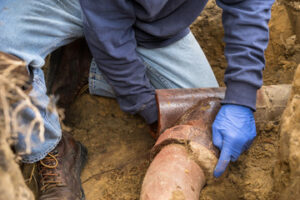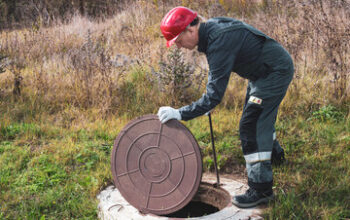Plumbers Bradenton are responsible for the pipes that carry water and waste into and out of homes and businesses. Without them, we wouldn’t have clean drinking water or functioning toilets.
Commercial plumbing is different to residential plumbing, as plumbers often work in large office buildings or industrial settings. This means that they need to follow stricter health and safety rules.
Trenchless technology is a modern way to repair sewer lines without extensive excavation. This method is much less disruptive to the surrounding landscaping, and it allows plumbers to complete repairs in a shorter amount of time. It also results in lower costs for property restoration and maintenance following the repairs.
There are two main types of trenchless sewer repair: pipe lining and pipe bursting. Both involve using specialized machinery to break apart and replace existing pipes. The exact process varies, but the general idea is that the new pipes are installed without damaging your home or garden.
The first step is to use a camera inspection to determine the type and extent of damage to your pipes. Your plumber will then select the best trenchless repair option for your situation.
If the pipes are in good shape but have a few cracks or leaks, your plumber may recommend pipe lining. This method involves inserting a thin liner made from resin into the damaged pipe. The liner is then inflated, creating a seamless pipe within the old one. This method is very effective and durable, offering a long-term solution to your sewer problems.
Trenchless pipe lining can be used on pipes with small cracks or a clog, but it won’t work for broken or collapsed pipes. If the pipes are too severely damaged, your plumber will probably need to use a different technique.
For more severe cases of damage, your plumber may choose to use the trenchless pipe bursting method. This involves pulling a new pipe through the existing one while shattering the old one. This method is a good choice for replacing older pipes or if the old pipes are located in a hard-to-reach place.
While trenchless sewer repair is a great alternative to traditional digging methods, it’s important to work with an experienced plumber. Not all plumbers are familiar with trenchless technology, and inexperienced technicians can cause costly damages during the repair or replacement process. If you’re thinking about upgrading your plumbing or are interested in energy-saving solutions, contact Bell Brothers today to learn more about the HERO financing program. Our HERO-approved specialists can help you find the right services for your home.
Trenchless Pipe Replacement
The pipes that transport wastewater to and from your home can develop issues over time. These issues can cause clogged drains and even property damage. Traditional repair methods for buried pipe lines involve extensive excavation work, which can take days and leave your property looking like a construction zone. Fortunately, modern plumbing technology offers less invasive options. These methods are called trenchless and can save you money, time, and stress.
Trenchless pipe lining is one of the most popular options for repairing aging sewer lines. It uses a high-definition camera to navigate through your pipes and identify the exact location of the problem. Then, plumbers can hydro-jet or manually clean your sewer line to remove any obstructions and prepare it for the lining process. The next step is to insert a flexible tube that’s saturated with epoxy into your old pipe. The liner will fill any gaps, cracks, holes, or channeling in your existing pipes and create a solid structural pipe inside of it.
Once your pipe has been relined, the plumber will inspect it again to make sure it’s working properly. If any further repairs are needed, your plumber can use the same method to repair them. With the exception of traditional excavation, trenchless pipe repair is much less expensive, faster, and more convenient than traditional methods.
Whether you have to replace an entire section of your sewer line or just a small part of it, the best option is a trenchless pipe replacement. This method is very effective, and you won’t have to worry about your landscaping or driveway being ripped up in the process.
Traditional pipe replacement methods can be very damaging to your property, but trenchless pipe replacement eliminates all of the mess and risk. This method is also very reliable, with most CIPP liners lasting 50 years or more. And, thanks to new UV curing techniques, these liners are now more durable than ever before. With a little care, your trenchless sewer line repair will last for years to come. To extend the life of your relined pipe, be sure to avoid plant growth near your pipes, keep it free of grease and debris, and have regular inspections.
Trenchless Pipe Lining
Trenchless pipe lining, also known as Cured-In-Place Pipe (CIPP) lining, is an innovative repair technique that avoids the need for extensive digging. In this method, plumbers use a soft and flexible liner imbued with resin to fill the inside of your damaged pipes, forming a new lining within your existing infrastructure that is highly durable and long-lasting.
The process is less invasive than traditional plumbing methods, and it can be completed much faster. Trenchless pipe lining is ideal for repairing a variety of issues, including cracks and leaks. However, it’s important to consult with a professional before deciding if this method is right for your home or business. The best way to determine if you’re a good candidate for trenchless pipe lining is by scheduling an evaluation of your pipes.
A sewer technician will begin the inspection by inserting a video camera into your pipes and viewing them from the inside. This helps the specialist locate the damage and identify what needs to be repaired or replaced. The technician will then discuss your options for completing the repairs.
Traditional excavation can disrupt landscaping, driveways, and other outdoor structures. In contrast, pipe relining requires minimal digging and can be completed in as little as an afternoon. It’s also a more affordable option than traditional plumbing techniques, saving you money on labor and restoration costs.
The main advantage of pipe relining is that it’s highly durable and cost-effective. It’s also environmentally friendly and preserves property aesthetics compared to traditional dig-and-replace methods. The lining is made of polyvinyl chloride (PVC) or epoxy resin, making it resistant to corrosion and able to support the weight of your pipes.
Occasionally, the lining material may fail to properly cure within your pipe walls. This is a normal occurrence in home and commercial plumbing, and it can be due to a variety of factors. If you experience a failed lining, your trenchless plumbing team will conduct a re-curing with a water circulation tube. During this procedure, the specialist will feed the tube into your damaged pipe and use it to cycle hot water through your pipes to liquefy the lining material and allow it to cure again.
Trenchless Drain Cleaning
When a homeowner notices clogged drains, they likely want the issue addressed right away. But they may dread the thought of their lawn getting torn up in the process. Fortunately, modern plumbing technology helps plumbers find the source of the problem and repair sewer lines without major digging.
The key to minimizing disruption is the trenchless technique called cured-in-place pipe (CIPP) lining. This method allows plumbers to restore sewer lines with minimal impact on landscaping and other property features. It also creates a strong, long-lasting solution that resists future damage from corrosion and tree roots.
Traditionally, plumbers had to dig up the entire length of the damaged line to perform repairs and replacements. But with CIPP lining, plumbers can restore the sewer line from an entry point that is typically near the house – such as a cleanout or a toilet drain.
There are several warning signs that indicate your sewer line is in trouble. For example, multiple clogged drains that can’t be cleared with a basic professional drain cleaning can signal a broken or blocked line. The clogged drains might emit foul odors or make gurgling noises when you flush the toilet.
Once the entry point is located, the plumber inserts a flexible liner that’s coated with an epoxy resin. It is then inflated inside the existing pipe, where it hardens to form a durable new liner. If the problem is more severe, plumbers might use a different method called pipe bursting to break apart the old pipe and pull in a new one. In both cases, the new liners are made of tough materials that are resistant to root intrusion and corrosion. The process is faster and less invasive than traditional excavation, making it a preferred method for most homeowners.

